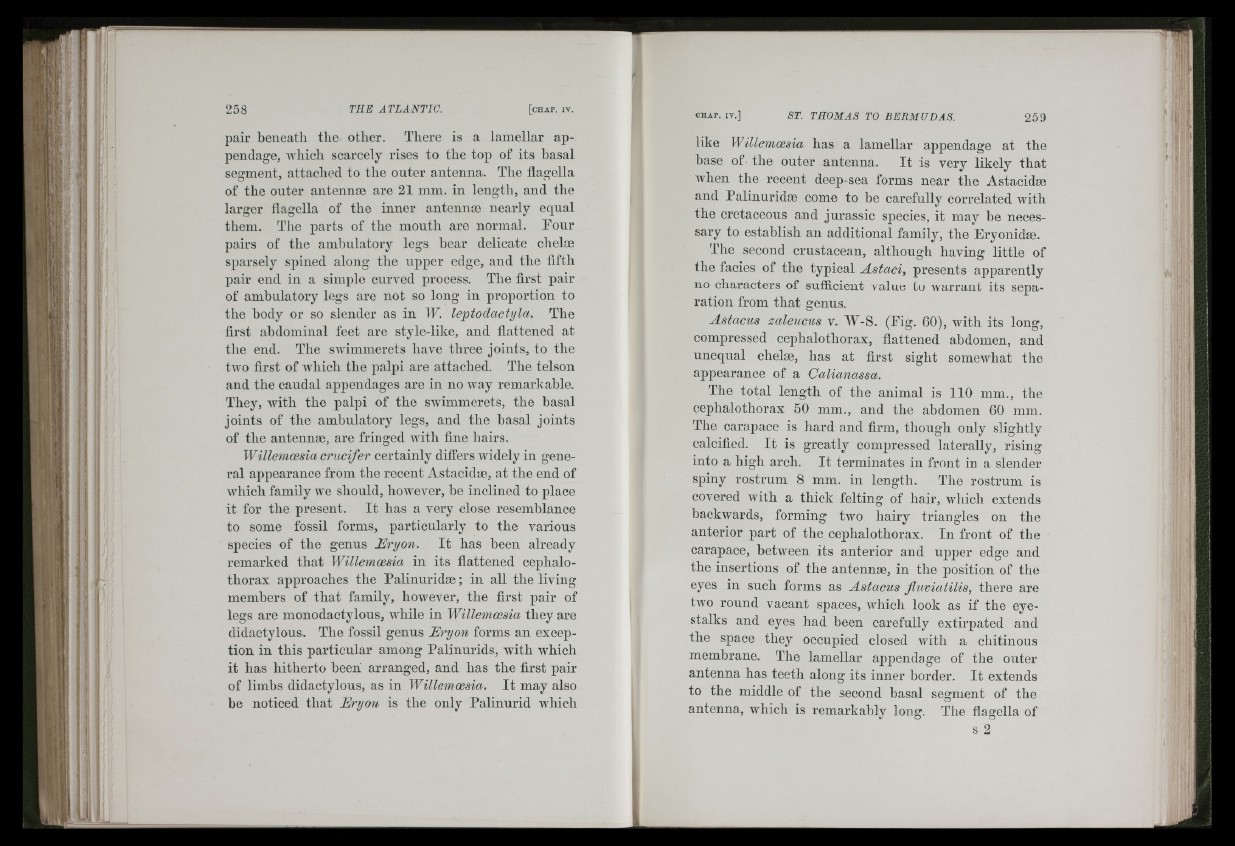
ir
258 THE ATLANTIC. [ c h a p . IV.
pair beneath the other. There is a lamellar appendage,
which scarcely rises to the top of its basal
segment, attached to the outer antenna. The flagella
of the outer antennæ are 21 mm. in length, and the
larger flagella of the inner antennæ nearly equal
them. The parts of the mouth are normal. Pour
pairs of the ambulatory legs hear delicate chelæ
sparsely spined along the upper edge, and the fifth
pair end in a simple curved process. The first pair
of ambulatory legs are not so long in proportion to
the body or so slender as in IP. leptodactyla. The
first abdominal feet are style-like, and flattened at
the end. The swimmerets have three joints, to the
two first of which the palpi are attached. The telson
and the caudal appendages are in no way remarkable.
They, with the palpi of the swimmerets, the basal
joints of the ambulatory legs, and the basal joints
of the antennæ, are fringed with fine hairs.
Willemcesia crucifer certainly differs widely in general
appearance from the recent Astacidæ, at the end of
which family we should, however, be inclined to place
it for the present. It has a very close resemblance
to some fossil forms, particularly to the various
species of the genus Eryon. It has heen already
remarked that Willemoesia in its flattened cephalo-
thorax approaches the Palinnridæ ; in all the living
members of that family, however, the first pair of
legs are monodactylous, while in Willemoesia they are
didactylous. The fossil genus Eryon forms an exception
in this particular among Palinurids, with which
it has hitherto been arranged, and has the first pair
of limbs didactylous, as in Willemoesia. It may also
be noticed that Eryon is the only Palinurid which
CHAP. IV.] ST. THOMAS TO BERMUDAS. 259
like Willemoesia has a lamellar appendage at the
base of the outer antenna. It is very likely that
when the recent deep-sea forms near the Astacidæ
and Palinnridæ come to he carefully correlated with
the cretaceous aud jurassic species, it may he necessary
to establish an additional family, the Pryonidæ.
The second crustacean, although having little of
the tacies of the typical Astaci, presents apparently
no characters of sufficient value to warrant its separation
from that genus.
Astacus zaleucus v. W-S. (Fig. 60), with its long,
compressed céphalothorax, flattened abdomen, and
unequal chelæ, has at first sight somewhat the
appearance of a Calianassa.
The total length of the animal is 110 mm., the
céphalothorax 50 mm., and the abdomen 60 mm.
The carapace is hard and firm, though only slightly
calcified. It is greatly compressed laterally, rising
into a high arch. It terminates in front in a slender
spiny rostrum 8 mm. in length. The rostrum is
covered with a thick felting of hair, which extends
backwards, forming two hairy triangles on the
anterior part of the céphalothorax. In front of the
carapace, between its anterior and upper edge and
the insertions of the antennæ, in the position of the
eyes in such forms as Astacus fluviatilis, there are
two round vacant spaces, which look as if the eye-
stalks and eyes had been carefully extirpated and
the space they occupied closed with a chitinous
membrane. The lamellar appendage of the outer
antenna has teeth along its inner border. It extends
to the middle of the second basal segment of the
antenna, which is remarkably long. The flagella of
s 2
ikî
vS'i